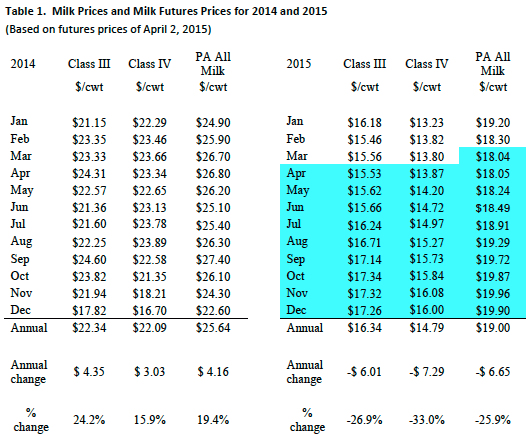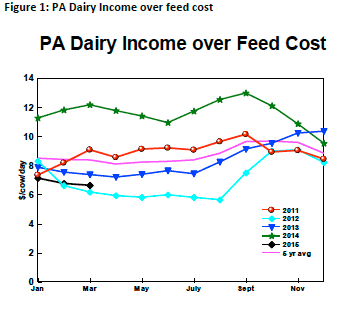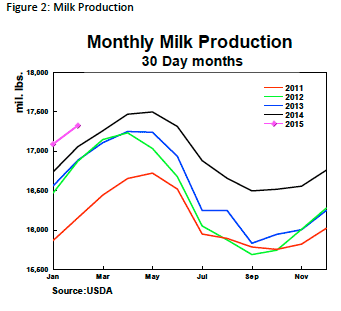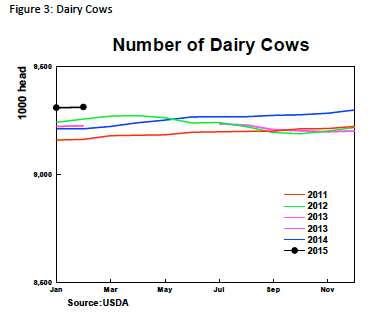
Market Psychology
By Jim Dunn
Professor of Agricultural Economics
Penn State University
Cheese and butter prices have increased slightly in the past month, while the powdered product prices have dropped almost 5%. Non-fat dry milk prices are down 4.9%, while dry whey is down 4.4%. The dollar's value is mostly unchanged, with the New Zealand dollar up 1.7% and the euro and Australian dollar down 0.6% and 0.9% respectively. The U.S. economy is still very strong, especially compared to Europe, which is stagnant. Also the Chinese economy is weak, which hurts dairy exports for everybody, but especially the United States. Of course, New Zealand and Australia are particularly dependent on sales to China, so they are really feeling the loss of the Chinese purchases. Total U.S. dairy exports have fallen to 2012 levels. Despite falling exports, milk production continues to grow. Butter prices slumped in early March, only to recover right at month's end, ending unchanged for the month. Cheese did much the same, ending up less than 1% from a month ago. The news for dairy markets has been largely negative recently, although the drought in New Zealand continues to hurt its milk production. The European dairy quotas ended April 1, so producers can expand, contract, or relocate as conditions warrant. The U.S. Dairy Export Council expects six countries to grow: Ireland, Denmark, France, Poland, Germany and the Netherlands. Germany, France, Great Britain, and Poland are the largest milk producers in the EU, so the fact that three of these four are on the predicted expansion list means the EU will be generating more surplus milk for exports. Of course, this will not happen overnight. In recent years, world dairy markets have grown so the world can probably absorb the higher production, but competing with a strong dollar will be a challenge.
Table 1 lists some past and estimated future milk prices. I estimate the March Pennsylvania all-milk price to be $18.04/cwt, down $0.26 from February. The official number will be released in late April. Although milk production has grown faster than domestic demand, the futures market prices for Class III and IV have risen somewhat for the first half of 2015, especially Class IV. The March Class III price was up $0.10 from February at $15.56/cwt. The latest Class III futures prices for the rest of 2015 average $16.54. The average Class III futures prices for all of 2015 are $16.34. The March Class IV price was down $0.02/cwt. from February at $13.80/cwt. The Class IV futures prices are higher for the remainder of 2015, averaging $15.50 for the next 9 months. My forecast for the average Pennsylvania all-milk price for 2015 is $19.00/cwt., or $6.65/cwt. below 2014.
The U.S. dollar is down slightly against the Euro and the New Zealand dollars since my last report, with the New Zealand dollar 3.0% higher and the Euro up 1.0%. The Australian dollar fell by 1.0%. The strong U.S. dollar continues to challenge U.S. exporters of dairy products.
Corn and Soybean Markets
Corn and soybean meal markets have been steady, as no significant news to change expectations. The South American corn and bean crops, China, and the strong dollar continue to hang over U.S. markets, but these items are essentially the same as a month ago.
Income over Feed Costs (IOFC)
Penn State's measure of income over feed costs fell by 1.9% in March, as milk prices fell by more than feed prices. Figure 1 shows how these values compare to recent years. March's feed cost is 5¢/cow/day less than in February. March's value for IOFC of $6.65/cow/day is well below the 2014 values, when milk prices were very high and feed prices were moderate. The change is because of a drop in the milk price, while feed costs are slightly lower. Income over feed cost reflects daily gross milk income less feed costs for an average cow producing 65 pounds of milk per day. Figure 1 and Table 2 showing the monthly data follow.
The allocation of the revenue per hundred pounds of milk (milk margin) is shown in Table 3. The milk margin is the estimated amount of the Pennsylvania all milk price that remains after feed costs per hundredweight of milk production are paid. Like income over feed cost, this measure shows that the March PA milk margin was 1.9% lower than in February.
Milk Production
The latest milk production report showed February milk production up 1.6% from a year earlier, a decrease from the monthly increases of recent months (Figure 2). This is a reasonable response to the falling milk price, since it is apparent that with lower dairy exports, the domestic demand for dairy products will not absorb the extra milk without prices falling. The monthly cow numbers are shown in Figure 3. The growth in cow numbers in February is negligible at 0.03%. Together these two measures indicate that the dairy farmers are finally reacting to the lower prices by limiting output expansion.






4.8.2015